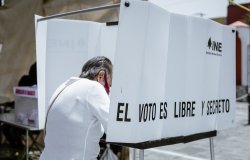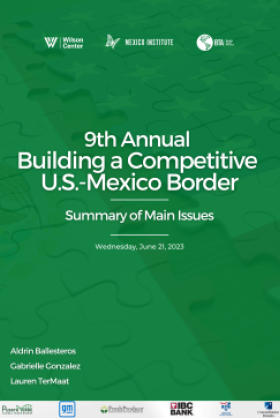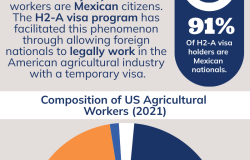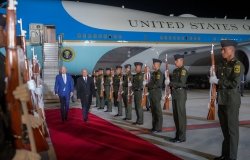Terror and North America: The Causes and Directions of Cross-Border Extremist Activity
Since the attacks of September 11, 2001, many American policymakers have grown increasingly concerned about terrorists or terrorist materials being smuggled into the United States from Canada. The myth that the 9/11 hijackers arrived in the United States through Canada contributed to the passage of laws that have increased the “thickness” of the border and hindered trade in the name of collective security. Do these rules safeguard against the true vectors of North American extremism? The Canada Institute’s “Terror and North America: The Causes and Directions of Cross-Border Extremist Activity” will examine how and why extremists travel between Canada and the United States, what effect these crossings have on our national security, and what possible policy solutions exist to better police the border.
Overview
Timothy Curry, deputy director for counterterrorism policy, Department of Homeland Security
Stephen Flynn, co-director of the George J. Kostas Research Institute for Homeland Security, Northeastern University
Christian Leuprecht, associate professor, Royal Military College of Canada
The attacks of September 11, 2001 violently shook Americans awake to the threat posed by international violent extremism. After the attacks, the United States’ domestic response focused on “thickening” its borders in an attempt to ensure that future terrorists could not infiltrate the country. While there have been no major attacks over the last decade, many analysts now question just how effective and necessary many of the post-9/11 security measures are. A new study by Christian Leuprecht of Canada’s Royal Military College uses social network analysis to track extremist border crossings to better understand terrorist behavior. The study argues that stricter border controls do not effectively address the problem of cross-border extremism, nor do they make Canada or the United States any safer. His study found that there were only a handful of cases between 1999 and 2011 when violent extremists crossed between United States and Canada. Perhaps more significantly, only two of those cases involved individuals trying to attack the country they were traveling to. According to the study, most of the crossings were made in an attempt to provide material support for terrorist operations overseas.
Using these new data, Leuprecht went on to describe inefficiencies of the United States’ national security policy. While billions of dollars have been spent to increase the number of law enforcement officers and electronic surveillance outposts, the data suggest that there is no systemic threat from extremists in Canada trying to enter the United States; the reverse is also true. With so few violent extremist crossings, and taking into account that only 2 percent of travelers is subject to search, heightened border security appears to have little impact on our continental safety. Leuprecht asks Canadian and U.S. policymakers to view national security through a holistic lens, taking into account all facets of extremism, and not fall victim to the hyperbole and alarmism that is rampant in both nations’ security dialogue.
Timothy Curry, deputy director of Counter Terrorism Policy at the Department of Homeland Security (DHS), echoed some of Leuprecht’s concerns. Curry laid out the three-pronged approach that DHS is using to use its resources more efficiently to keep Americans safe. The first focus is on data-driven research, similar to Leuprecht’s study. DHS has commissioned studies to determine the types of threats the United States faces and what type of networks move personnel and materials across the U.S.-Canada border. The second focus Curry emphasized was the use of international partnerships to multiply border resources. Better communication with Canadian partners helps DHS better allocate sparse resources and makes our border more secure. Finally, Curry spoke about community engagement as the third and potentially most important method for curtailing cross-border terrorist traffic. Making clear that only a portion of violent extremists were Islamists, he cited the case of the Somali community in Minneapolis as an excellent example of community outreach that gave law enforcement officers the data they needed to interdict a terrorist operation there.
It is virtually impossible to patrol the entire 5,525 mile-long U.S.-Canada border with the aim of interdicting terrorist threats, said Stephen Flynn. Citing the only successful interception of a violent extremist (Ahmed Ressam) who traveled from Canada to the United States with the intent to commit a terrorist act, Flynn argued that the interdiction was due to luck and the intuition of border agents rather than any specific cross-border inspection regime. In fact, this one success came 18 months before the 9/11 attacks occurred. Rather than contributing to a thickening of the border, Flynn advocated a freer flow of goods, stating “a more efficient border is a more secure border.” By making the border less of a barrier, there is a less attractive market for both terror and crime networks.
The shared infrastructure of the United States and Canada makes it an attractive target for violent extremists. Flynn implored policymakers in the United States and Canada to view targets not as physically vulnerable objects, but rather vulnerable conduits of vital transportation and energy. Reorganizing our thinking about why violent extremists pick their targets will allow the United States and Canada to more ably defend our shared infrastructure and enhance the flow of goods, information, and energy.
While the threat of cross-border violent extremist activity persists, both Canada and the United States would be wise to reframe the national security debate. A holistic, balanced approach based upon analytical data would help ensure a prosperous and safe future for both countries.
Speakers
Christian Leuprecht
Stephen Flynn

Barbara Falk
Associate Professor, Department of Defence Studies, Canadian Forces College (Toronto)
Timothy Curry
Hosted By

Canada Institute
The mission of the Wilson Center's Canada Institute is to raise the level of knowledge of Canada in the United States, particularly within the Washington, DC policy community. Research projects, initiatives, podcasts, and publications cover contemporary Canada, US-Canadian relations, North American political economy, and Canada's global role as it intersects with US national interests. Read more
Thank you for your interest in this event. Please send any feedback or questions to our Events staff.









